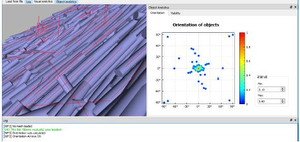Information
- Publication Type: Bachelor Thesis
- Workgroup(s)/Project(s):
- Date: January 2018
- Date (Start): 2017
- Date (End): 25. January 2018
- Matrikelnummer: 1425235
- First Supervisor: Eduard Gröller
Abstract
Fiber-reinforced composites are materials used for their extraordinary characteristics. The importance of these materials is constantly increasing, therefore, a wide range of variations exists of this material. Types range from Carbon Fiber Reinforced Polymer to Fiber-reinforced Foamed Urethane and more. Fiber-reinforced composites are lightweight, strong, and durable, among others and are therefore used for printed circuit boards, railway sleepers, airplanes or Formula 1 vehicles. To assure that these materials provide the required quality, they need to be tested and analyzed. To analyze these materials or to be more exact, the fibers within, special tools are needed. The first step is to scan the material with a X-ray Computed Tomography (CT) and save it as a volumetric CT-image on a computer. Now this data can be used to analyze the structure and find flaws in the dataset. In this thesis, a program for a later integration in a software called open_iA to extend its range of features, is developed. Purpose of the developed program is to analyze the orientation of fibers in a dataset. The result will be visualized with two different graphs. One shows the orientation of the fibers, while the other shows how many fibers are visible to the analyst. With the option of different configurations, it is possible to further specify these visualizations and get a better understanding of the underlying data.Additional Files and Images
Weblinks
No further information available.BibTeX
@bachelorsthesis{lipp-2017-mgpu,
title = "Visualization of Fiber Orientation in Glass Fiber Reinforced
Polymers",
author = "Lukas Lipp",
year = "2018",
abstract = "Fiber-reinforced composites are materials used for their
extraordinary characteristics. The importance of these
materials is constantly increasing, therefore, a wide range
of variations exists of this material. Types range from
Carbon Fiber Reinforced Polymer to Fiber-reinforced Foamed
Urethane and more. Fiber-reinforced composites are
lightweight, strong, and durable, among others and are
therefore used for printed circuit boards, railway sleepers,
airplanes or Formula 1 vehicles. To assure that these
materials provide the required quality, they need to be
tested and analyzed. To analyze these materials or to be
more exact, the fibers within, special tools are needed. The
first step is to scan the material with a X-ray Computed
Tomography (CT) and save it as a volumetric CT-image on a
computer. Now this data can be used to analyze the structure
and find flaws in the dataset. In this thesis, a program for
a later integration in a software called open_iA to extend
its range of features, is developed. Purpose of the
developed program is to analyze the orientation of fibers in
a dataset. The result will be visualized with two different
graphs. One shows the orientation of the fibers, while the
other shows how many fibers are visible to the analyst. With
the option of different configurations, it is possible to
further specify these visualizations and get a better
understanding of the underlying data.",
month = jan,
address = "Favoritenstrasse 9-11/E193-02, A-1040 Vienna, Austria",
school = "Institute of Computer Graphics and Algorithms, Vienna
University of Technology ",
URL = "https://www.cg.tuwien.ac.at/research/publications/2018/lipp-2017-mgpu/",
}


 Bachelor Thesis
Bachelor Thesis
